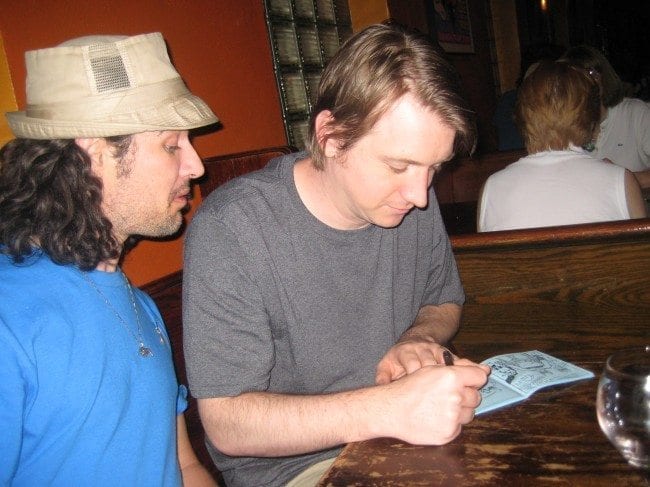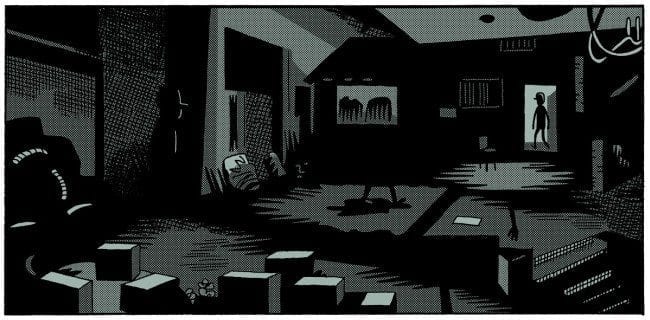Life gets in the way sometimes, so it's story time.
Drove from Pittsburgh, Pennsylvania to Tulsa, Oklahoma and back. Sixteen hours each way. Stayed a week in Tulsa. Family stuff. My girl's mom is ill. Total bummer but good family time. You know the drill. 'Nuff said.
Stopped in St. Louis. Saw Kevin Huzienga, Dan Zettwoch, Ted May, and Sacha Mardou on the way back. What wonderful people. What talented folks. I am lucky to have such friends. When the below photos were taken, Kevin's wife, Katie, was babysitting Ted and Sacha's daughter, Veronica.

We did some jam drawings. I re-introduced Kevin to the joy that is the Pentel Rolling Writer pen. Alex Toth's pen of choice. All those model sheets that Toth is famous for? Rolling Writer.
Dan Zettwoch is getting married. I wish I could be there. I bet he would make certain that the guests had a good time. Somehow, carnival rides are part of the festivities.
Ted May is finishing up the new issue of Injury. I implored him to make a limited edition at standard comic-book size. He said he was continuing to draw his originals at the same size. I said that I selfishly just wanted the series to all fit in the same box. "No one has figured out how to store mini-comics yet," I said.
Sacha is apparently working on a 350-page graphic novel. She said that she has the whole thing drawn in pencil already. Check out her stuff here.
We talked shop and talked shit. Nothing serious. At one point Dan said, "Oh, there's Leon." I guess this guy has a speaking voice that is what Dan imagines Leon would sound like. I waved to him for some reason. I felt like I knew him already. (For those who don't know, Kevin and Dan do a weekly comic strip in a St. Louis newspaper that features a "Leon" character.)



I ranted that I'm not going to scan the jam drawings we were doing at the table and post them. Why? Cuz some loving-no-harm-meaning fan will just drag the images off this post and put them on his tumblr without crediting any of us. That's why. It's annoying. I whined about how I see the drawings from my workbook series on other people's tumblrs or blogs without any link to my original post or even my name. It's not that big of a deal but it really is annoying. So, dear readers, if you like my workbook series and like to re-post the drawings that I do to illustrate my writings, um, would you please credit me under the image? Am I being selfish? Please forgive me. Thank you.
Maybe I'll do something really wild and make a mini-comic of the jam drawings and just give them away. How quaint, eh? Sitting there with the captains of the USS Catastrophe, the thought did cross my mind. Here were some real experts on mini-comics. We all worked our asses off in that tiny community back in the day. And they still do now, really, with the Catastrophe shop. But when I think about how blogs and web comics have changed the mini-comics scene, I realize Bill Boichel was right: mini-comics, zines, and things like Factsheet Five were the Internet in embryonic form. Portals and connections and links. Spit and a Half was like Google.
The next day Kevin showed me his mini-comics library over at his house. I think he may have answered the question of how to store mini-comics: just have stacks of them spilling all over the place. Wasn't he married to a librarian? I never saw such a collection of rarities and greatest hits. "You should see Ted's collection," he said. Kevin has all the best Joel Orff comics. All the best of Dylan Williams' issues of Eighty-Six. Crazy one pagers by CF. He had copies of zines I had made that I had lost my last copy of, the printing originals long lost too. It was like a dream. Like driving a thousand miles, and then there is a small room in a suburban house with stacks of handmade art. And in each stack there is a piece of paper with my drawings on it - in an envelope with a label that had some ancient and forgotten address of a place where I once had lived. I lost my mind. One of the best collections of mini-comics that I've ever seen.
And Kevin was riffing on how he found his way to mini-comics and how he started making his own. It was a great story. He talked about Destroy All Comics, Jeff Levine's and Dylan Williams' zine from the mid '90s, and how that was a big deal for him. He bought Storeyville at Quimby's. And ordered my zines through John Porcellino. He told the story of just following the trail through the microscopic scene and it really almost made me cry. I think Kevin is one of the most talented artists in the world and ... it made me feel like that little scene really mattered. And that in some way, the scene fostered that talent (just like the Catastrophe guys have fostered countless folks). I think Bill Boichel said that he sold over 200 copies of Kevin's self published mini-comics masterpiece, Gloriana, at his store back in the early aughts. That's 200 copies at one store, boys and girls. Pittsburgh, PA has a lot of Kevin H fans. The microscopic scene of the '90s morphed and a few stores really pushed folks like Kevin before there were any wide releases by bigger publishers. That's a fucking scene. I just saw the line from the '90s to now and I saw it in my mind like a beautiful graph. I wasn't even stoned or anything.
Does this story matter to you, dear reader? Well, I hope so. I don't mean to sound like the nostalgic old guy, but, we didn't know how good we had it back then. Everyone is too busy checking their Facebook these days to give mini-comics that same white hot focus. Seriously, you guys, that was a fun scene for a minute. Ed Brubaker used to walk among us, haha.
Then Kevin showed me the new issue of Ganges that he just finished. He was showing me the pages on his computer and then he busted out the originals when I asked him about his process. His original pages have a lot of "color holds," guidelines for the colors that he creates by layering shapes and textures in Photoshop. When it's just his character Glenn walking outside in the daytime, it's a pretty straight forward line drawing. But when he has Glenn walking through a dark room he just has these silhouettes of Glenn drawn in pen. See example panel below.




I asked him how he found those lines and he said he works up the drawing in pencil, finds the highlights or shadows, and then draws a black line around them. Then he erases the pencil underdrawing (please make a scan of these, Kev, geez, they must have been pretty drawings) and scans the "color holds" into Photoshop. Simple. It's remarkable how much the coloring completely changes how the original pages read, tho. He's really working up the images from light to dark more and more. There seemed to be more panels and pages built this way than the traditional black line art where each figure is completely rendered with black outlines around every shape. It's a remarkable book from a "how did he do it?" approach alone and, from the looks of it, from the story too. Form and content. Words and pictures. Dots and lines.






